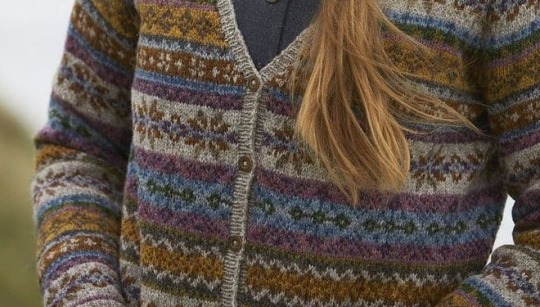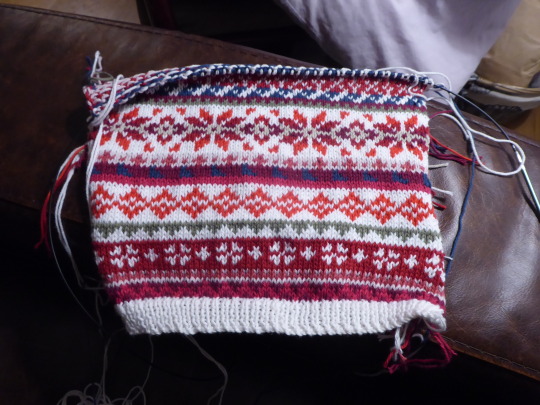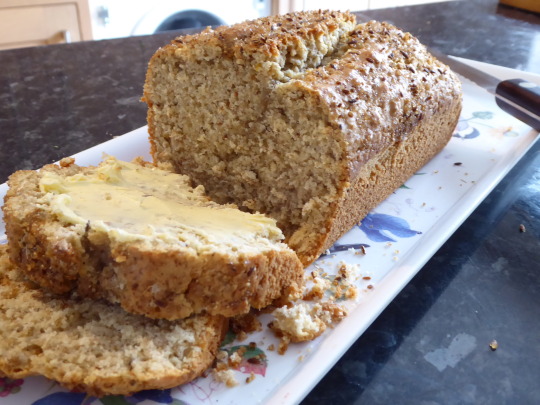The Girl in the Moon wanders away from the library and shares bits and bobs. Expect food, knitting, photographs, John Dee, old books and similar.
Don't wanna be here? Send us removal request.
Text
Christmas in August
Every year should have a mammoth knitting undertaking that makes me wonder if I’ve bitten off more than was sensible.
This year it’s been knitting a fairisle cardi in flat pieces, in a non-wool yarn, and then learning to set in sleeves to get the thing assembled. All while the recipient was 180 miles away and thus quite unavailable for fittings.
But it didn’t turn out ‘alf bad, if I say so myself.

This is my lovely mum graciously wearing a Christmas cardigan in August so that I could photograph my handiwork. The pattern is Marie Wallin’s Ninian.
Last Christmas (urgh... last Christmas...) mum mentioned that she might like a Christmas cardi, so what could I do but try to oblige in time for the next festive season?
I picked Ninian because mum likes a V-neck and dislikes anything too thick and bulky, meaning 4ply was the way to go, yarn-wise. I wanted a pattern that wasn’t overtly Christmassy (no reindeer, no trees, no santas...), so that it could be wearable beyond December. Oh, and the much missed Liz had Wallins’ Shetland book and was willing to lend it, which kinda helped a bit, too.

I completely reimagined the colour scheme for the cardi to turn it from ‘subtle modern twist on traditional Shetland design’ to ‘Christmassy without being completely gaudy’. It took several goes to get the new colour scheme right, and some of the yarn colourways I bought weren’t used in the final iteration at all (charcoal and bright leaf green both bit the dust because they just wouldn’t play nicely with the others).
The overall effect was inspired by a Vogue Knitting pattern for a Christmas cardi, from which I particularly stole the addition of dark teal into the more expected Christmas palette of red and green.

The yarn is Hjertegarn Blend Tendens, which is a 50/50 cotton/acrylic 4ply blend. Mum doesn’t wear wool, so I had to branch out into non-animal fibres for this. I was pretty wary about how they’d work for stranded knitting, but it actually wasn’t a problem at all: it played very nicely in the pattern and wasn’t hard on the hands to knit with. I did modify a couple of rows of one of the motifs to remove a 13-stitch float, which I thought would be a bit too long in a non-sticky yarn.
I picked the Hjertegarn because it comes in a really wide variety of bright shades, and not just a handful of baby pastels. I’d not bought from Rito Hobby before, and was a little nervous about them seemingly being a Denmark-based firm (post-Breixt import charges are a mystery to me), but they have a UK-based office or something, so it’s just like buying from a UK company, except that the parcel originates from Denmark somewhere.

My swatch cheerfully survived machine washing, and the yarn played nicely with steam blocking, too. What’s not to love?
The project overall turned out incredibly bittersweet: I’d be throwing ideas for it around with Liz for a couple of months, and she lent me a stack of fairisle books, and then I’d barely started knitting in earnest when she died. I’d be very much looking forward to showing her the work in progress when we met on the village green for tea, and -- frankly -- to having her guide me through the making-up process. Still, I muddled through it all and the seams turned out surprisingly well, all things considered. I’d only ever mattress-stitched cuddly toy clothes before, and there’s rather more room for manoeuvre there.
The sizing worked out well, too. It’s helped by mum and I being pretty much the same height and arm length. But even so, I didn’t fancy starting all over again if it’d turned out to be way off!
Project stats
Pattern: Ninian, by Marie Wallin, in the smallest size
Yarn: Hjertegarn Blend Tendens
Needles: 2.75mm for the ribbing, 3.25mm for the rest
Mods: completely reworked the colour palette, small change to one motif to reduce float lengths, worked arms and body shorter than stated, skipping over the lightly-patterned sections immediately after the ribbing.
Started: March 2021, finished August 2021:
3 notes
·
View notes
Text
Scone-y seedy cake

Ingredients
1 dessert spoon caraway seeds
1 tsp green aniseed (or fennel seeds?)
3 oz margarine (or butter)
3 oz sugar (caster and demerara mixed) + a little extra
1 tsp lemon zest
1 egg
Splash of sherry
2 oz rye flour
4 oz self-raising flour
1 tsp baking powder
Milk
Method
Grease and line a loaf tin. Heat oven to 180C
Toast seeds in a dry frying pan for a few minutes, grind with pestle and mortar
Cream fat and sugar, stir in two thirds of the seeds and lemon zest
Mix in egg, flour, baking powder and sherry
Add splash of milk if dough very thick
Put dough in tin
Mix demerara sugar with remaining seeds and sprinkle across top of cake
Bake for 30 minutes or until a skewer comes out clean
Serve warm or cold spread with butter
3 notes
·
View notes
Text
Fig and pink peppercorn cake
OK, I’ll admit it. This sounds more like something from one of the early medical books I deal with at work all day than it does like a scrummy cake. But actually, it’s a bit of a hit, tastebud wise, so I’m recording it for posterity.

Inspiration came from a forgotten bag of dried figs that need using up. Contemplating them, I found myself thinking of the pot of under-used but much-loved pink peppercorns lurking in the spices box. (I think they fell into my basket in the Indian spice shop on Drummond St, but it may have been somewhere else.) A bit of Googling revealed that I wasn’t completely out of my tree -- Ruby Tandoh has a black pepper fig roll recipe -- so I launched ahead.
The resulting cake is spicy and soft, sweet but not over-powering and a bit, well, peppery. In a good way.
For the cake
4oz dried figs 1/2 tsp pink peppercorns 1/2 tsp vanilla essence 2 eggs 4oz margarine or butter 2oz light brown muscavado sugar 2oz soft dark brown sugar 1 large dessert spoon golden syrup 1 dessert spoon black treacle 3oz rye flour 3oz plain flour 3 1/2 tsps baking powder
For the icing
Cream cheese, icing sugar, a tsp ground pink peppercorns (I’d stopped measuring by this point)
Preparation
Day before: soak the figs in enough hot water to cover them.
On the day: line a 1lb loaf tin; pre-heat oven to 180C (electric), 160C (fan) gas mark 4ish?
Method
Add the 1/2 tsp of peppercorns to the figs; blend them with a hand-held blender; then beat in the eggs and vanilla.
In a saucepan, melt the margarine/butter, sugar, syrup and treacle over gentle heat until combined; allow to cool a little.
While the sugar mixture is cooling, mix the flours and baking powder together.
Carefully mix the warm mixture into the fig mixture, then beat in flours and baking powder.
Cook in the over for 30 minutes until well-risen and a skewer comes out clean.
Icing
Bash up the peppercorns. Beat some cream cheese with some icing sugar until it resembles cream cheese icing. Mix in some peppercorns and use some to decorate top of cake.
1 note
·
View note
Photo

Orange, ginger and cardamon cake
Inspired by Damyanti: the same basic recipe as my lemon drizzle, but flavouring the cake with the zest of one large orange, 1 heaped tsp of ground ginger and 1/2 heaped tsp of ground cardamon. Iced with a little orange juice mixed with icing sugar.
0 notes
Text
Easy-peasy lemon squeezy
Easiest lemon drizzle cake
I’ve known various lemon cake recipes, of various levels of complexity. This one’s easy, quick and reliable. It’s probably mostly plagiarised from somewhere, but I’ve lost track of where.
Equipment: loaf tin
Oven: 180C (electric), 160C (fan), gas mark 6ish
Ingredients
4oz margarine
4oz white sugar (caster or granulated)
2 eggs
6oz flour
splash of milk
one lemon
extra white sugar
Method
Zest the lemon and cream it tog the margarine and sugar together until light and fluffy.
Stir in the egg and flour well, adding enough milk to make a smooth but still thick consistency.
Bake for around 30 minutes, until a skewer inserted into the cake comes out clean.
While the cake is cooking, juice the lemon and mix the juice together with enough sugar to make a gloopy syrup.
As soon as the cake comes out of the oven, pierce it all over with a skewer and pour the syrup all over it.
Leave it to cool before turning it out
0 notes
Text
Dee-lightful
Shout-out to Pater for emailing me about this exhibition!
The exhibition is located at the Royal College of Physicians. On their premesis they have a library and carver out an exhibition space. It’s realivily small (a room and along three walls). A little different than the museums with their own specific buildings that I have been mostly writing about.
A WHO conference was actually happening when I was there! Pretty swank actually! I literally rubbed shoulders with fancy doctors.

Scholar, courtier and magician: the lost library of John Dee
The exhibition features about 100 books in the Royal College’s Library that belonged to John Dee!

In his life, Doc Dee collected over 4,000 books during the Tudor Era (think King Henry VIII and Queen Elizabeth I). THAT IT A LOT.
Warning for book lover- the next sentence is super sad. When John went away on work for the royal court and the person looked after his house SOLD the BOOKs. ALL THE BOOKS WERE GONE. HE SPENT HIS LIFE COLLECTING THEM.

Wondering how they know which ones were his?
Dee was quite the Doodler! All of the books he owned have annotations and drawings. I mean look at that ship!

Dee’s famous for being a magician and the inspiration for Shakespeare’s character Prospero in The Tempest. But in fact he was mostly a mathematician. Though he did try to talk angels. So there’s that…

I really liked how they integrated his doodles into the imagery of the exhibition. On the wall were huge panels with combinations of text, images, quotes, maps and timelines. Below in the cases were books from the collection.
For this exhibition they x-rayed a massive painting and found some secrets underneath! Check out the article here!
I couldn’t get a good photo of the painting but when you went up close you could see the under layer of paint making its presence know.
Wicked!
Rating: 7/10
Pros: Detailed and overarching discussion about John Dee, cute interactive, great visuals, use of collection and connections to history, short and sweet, interesting topic, beautiful location
Cons: The space is quite small and I definately bumped doctors with my school bag, there were no signs not to use flash photography (a must with books!), needs more sinage to the other display room.
33 notes
·
View notes
Photo

I’ve got a new gansey under way. Exciting times :) (First gansey knitted 2012-2013.)
1 note
·
View note
Photo

Finally, a glimpse of winter in London. (Wednesday 20 January.)
1 note
·
View note
Photo



My fourth pair of socks from Rachel Coopey’s Coop Knits Socks (vol 1). I’m loving these patterns; this one is Budleigh.
1 note
·
View note
Photo

These mittens didn’t want to be knitted - it took far too many tries to get each bit right. But success in the end. Phew!
Based on the Endpaper Mitts pattern. Jamieson & Smith Shetland Heritage yarn on 2.5mm needles. Worked two-at-a-time
Ravelry project page
1 note
·
View note
Photo

Such fun knitting this. The plötulopi was much less intimidating to knit with than I’d thought it might be.
Ravelry project page
1 note
·
View note
Photo

A splash of colour in the greyest time of the year.
Ístex Einband yarn held double on 2.25mm needlesm lined with laceweight BFL/silk.
Ravelry project page.
1 note
·
View note
Photo

Is it time to indulge in my fondness for marginal doodles that have absolutely nothing to do with the content of the actual text? LJS 231 contains details on Italian tax regulations and retail measures, though you wouldn’t know it from these figures on fol. 27r– the skeletal Komodo dragon is my favorite.
Manuscript description and digital images can be found here at OPenn, and you can download an ebook version here.
82 notes
·
View notes
Photo

Three-dimensional geometry explained with foldout diagrams in Euclid, trans Billingsley, The elements of geometrie, 1570. This was the first English translation of Euclid, and John Dee wrote an extensive preface to it.
The RCP library has the largest known collection of books from John Dee’s library, going on display from January 2016.
3 notes
·
View notes
Photo

One of twelve volvelles in Trithemius, Polygraphie, 1561. The title written on the fore-edge of this book suggests that it belonged to John Dee. It's a book about cryptography, and the volvelles are cipher discs used to encoding or decoding text.
The RCP library has the largest known collection of books from John Dee's library, going on display from January 2016.
536 notes
·
View notes
Photo







Machrihanish pullover by Kate Davies. Project page.
3 notes
·
View notes
Photo





Icelandic present yarn knitting: shawl and hat.
1 note
·
View note